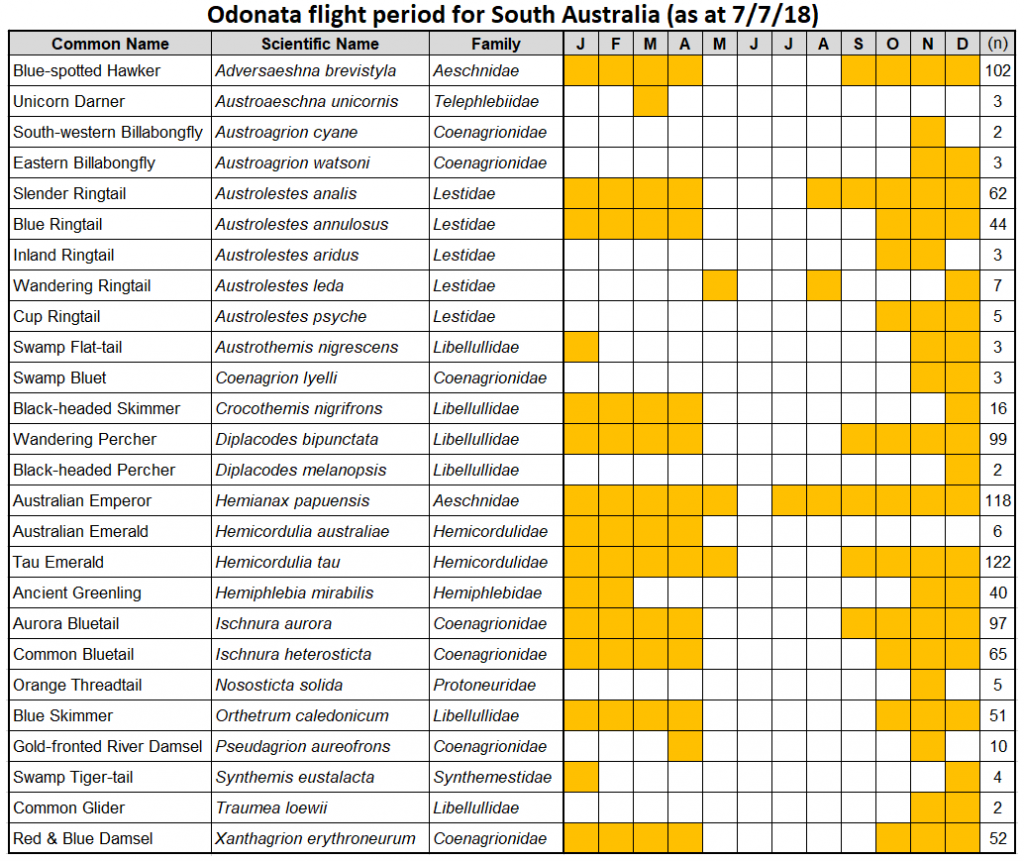When do Dragonflies and Damselflies hit the skies? Check out this flight period chart to find out…
Dragonflies and Damselflies are fascinating creatures. The main difference between the two groups (as outlined in Part I) is the appearance of their wings and whether they can fold their wings when at rest. As adults, they eat smaller insects on the wing and live for just 1 to 3 months.
Did you know that after mating, dragonflies and damselflies lay their eggs in aquatic vegetation, soft mud or directly into water? The waterbody, in which the insects hatch and live their larval stage, may be as big as a wetland or as small as a temporary pond. As aquatic macro-invertebrates, damsel- and dragonfly larvae eat other smaller waterbugs and undergo up to 15 moults before the nymphs metamorphose into the amazingly colourful flying insects we are familiar with. If you haven’t managed to follow the three previous parts of this series you will be able to become familiar with species known from the South East of SA and SW Victoria. (Part II & Part III).
Dragonflies can fly many hundred of kilometres from their birth place to opportunistically inhabit new sites, while damselflies are generally weak flyers and remain in close proximity to their site of origin.
The flight period of insects is an interesting component of their ecology and, at a local or regional scale, the month of observation can be an important factor in identification, particularly in cooler temperate parts of Australia – unlike the tropics where flight periods can be continuous. Here, in this part of the country, we have a defined start – influenced by increasing air and waterbody temperatures – and a clear end point, when the activity level of adults significantly decreases (resulting in death). The timing of decreased adult insect activity is influenced by a decrease in air temperatures, reduction in sunlight and food resources, and more constant rainfall periods making life ‘difficult in the air’.
The following table is a summary of my observations of the adult flight periods for dragonflies and damselflies in South Australia, especially the South East of the state. The table summarises the number of field observations (n) per species shown. Species were identified in the field through close observation using 10×42 binoculars, or were later identified from photographs and online identification tools (by Richter) or field guides (by Theischinger and Hawking)

NOTE: This chart is most relevant to the SE of SA, especially with regards to Gold-fronted River Damsel and Orange Threadtail as they are not known from the SE of SA, however have been observed in the Adelaide-Mt Lofty Ranges region.
A flight period table such as this can be useful in the identification of damsel- and dragonflies (as well as other insects like butterflies, moths and cicadas). As described above, weather conditions (seasonality) influence which species are flying and those that are not. So, a good understanding of flight periods, along with field and photographic guides, will help you to accurately determine which species you are observing at your favourite wetland or waterbody.
I imagine in the coming weeks once the sun emerges from behind the clouds we will again commence the Odonata flight season and begin to see Australian Emperor, Wandering Percher, Tau Emerald and a host of damselflies.
Happy Odonating!!

